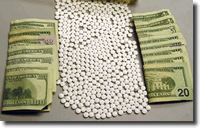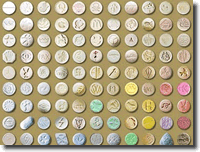
Ecstasy Statistics
-
According to ecstasy statistics from the Drug Abuse Warning Network, during 1998 through 1999 deaths from ecstasy increased 400%. Between 1996 and 1999, emergency room visits involving ecstasy grew by nine times, from 319 to 2,850. The majority of these cases involved users under 25 years old.
-
According to the U.S. Drug Enforcement Administration, 8.1 million Americans 12-years and older tried ecstasy in 2001, up from 6.5 million the year before.
-
Ecstasy statistics show that between 1995 and 2001, the number of teenagers using ecstasy increased by 140%.
-
92% of those who begin using ecstasy later turn to other drugs including marijuana, amphetamines, cocaine and heroin.
-
3,4-METHYLENE-DIOXYMETAMPHETAMINE (“MDMA”) is the chemical name for “ecstasy.” It is a synthetic psychoactive drug that possesses the stimulant properties of methamphetamine and hallucinogenic qualities most similar to mescaline.
-
MDMA is not new. It was first developed in 1912 as an appetite suppressant by the German pharmaceutical company Merck. During the late 1970s, psychologists and psychiatrists used the drug as treatment for psychological and emotional disorders. Street use of the drug became popular in the 1980s; it became illegal in the United States in 1985.
-
In its purest form, ecstasy is a white crystalline powder with a musty odor. It may also have a reddish or brownish color as a result of impurities. It usually comes as a tablet, capsule or in powder form and is usually taken orally, although it can be injected. Ecstasy statistics reports that the quantity of MDMA can vary from 9mg to 117mg per tablet.
-
A study by the Institute for Prevention of Alcoholism and Other Addictions in Switzerland found that 55% of those who use ecstasy suffer some negative consequence. These side effects included: 55% feeling of losing control, 50% anguish and fear, 49% fatigue and bad mood, 45% depression and sadness, 36% problems with family, friends, spouse or others, 33% disagreeable hallucinations, 32% anguish or paranoia, 24% sick feeling and/or fainting, 15% problems at work or at school, and 8% problems with the police.
-
Ecstasy is illegal. The Drug Enforcement Administration classifies it as a “Schedule I” drug, a description reserved for dangerous substances with no recognized medical use. Other “Schedule I” drugs include heroin, cocaine, LSD and amphetamine.
-
Ecstasy statistics notes that penalties for possession, delivery and manufacturing of ecstasy can include fines up to $100,000 and up to 99 years to life in prison, depending on the amount of the drug you have in your possession.
-
Most ecstasy is only 40% pure so there is always a risk that any pill or gelatinous capsule of ecstasy may have been “cut” (combined) with other drugs such as heroin or cocaine, which are addictive.
-
Ecstasy statistics show that a person has to continually increase the amount of the drug they take in order to feel the same effects. Users say the effect of ecstasy is greatly reduced after the first dose. And as a person takes more of the drug, the negative side effects also increase. Because the desired effect from using the drug diminishes, a person often then tries other drugs which are even more dangerous and do cause the user to become addicted.
-
Users feel there is sometimes a need to use other drugs such as heroin or cocaine to help cope with the mental and physical pain that results after one “comes down” from ecstasy; 92% of those who take ecstasy also abuse other, even harder drugs. A person often then tries other drugs which are even more dangerous and cause the user to become addicted.
-
The false idea that a person only feels good with ecstasy leads to a desire to take it more often than just at raves and techno parties; ecstasy statistics show that 67% of those who use the drug want to continue taking it, despite having bad experiences.
-
Nearly 100 studies have been conducted on ecstasy. They show that:
-
The absorption of even half a pill of ecstasy can cause grave symptoms, as in the case of an 18-year-old girl who needed a liver transplant to save her life after taking the drug.
-
Ecstasy is sometimes mixed with other dangerous substances.
-
Young people have died from dehydration, exhaustion and heart attack as a result of taking too much ecstasy.
-
Ecstasy can cause kidney, liver and brain damage, including long lasting lesions on brain tissue.
-
Even a small amount of ecstasy can be toxic enough to poison the nervous system and cause irreparable damage.
-
Ecstasy can modify DNA structure, causing genetic damage.
-
Ecstasy statistics notes that recently the consumption of one to five tablets of ecstasy was enough to cause heart attack in seven people ages 16 to 25.
-
Under the influence of ecstasy, drivers have started to “float” behind the wheel, losing control and killing themselves or others on the highway.
-
Ecstasy, while popularized in America's clubs and raves in the 90's, first officially arrived in emergency departments in 1994. Ecstasy statistics reports that year there was a reported 253 cases for Ecstasy in our nation’s ER departments. And while people under 25 make up 1/3 of all drug cases that come into the emergency department, they comprised 80% of the Ecstasy cases, an overwhelming majority.
-
For the third year in a row, ecstasy statistics have found that the percent of 8th graders who perceived low risk of harm from using ecstasy fell from 52% in 2006 to 46.8% in 2008. For 10th graders, that decline was from 71.3% to 66.4% and for 12th graders it only fell slightly, from 59.3% to 57.0%. Additionally, first time users were reported at 781,000 in 2007, a marked increase from the 615,000 first time users reported in 2005.
-
Ecstasy statistics reports that there is an overall decrease in the percent of children who have tried Ecstasy in their lifetime, from 2003 to 2008, which is promising. It is quite interesting to note that while the overall perceived danger of the drug declined, the overall lifetime statistic has dropped. It has also been reported by many studies that the over median age of recreational users of MDMA has increased, in the past 5-6 years.










